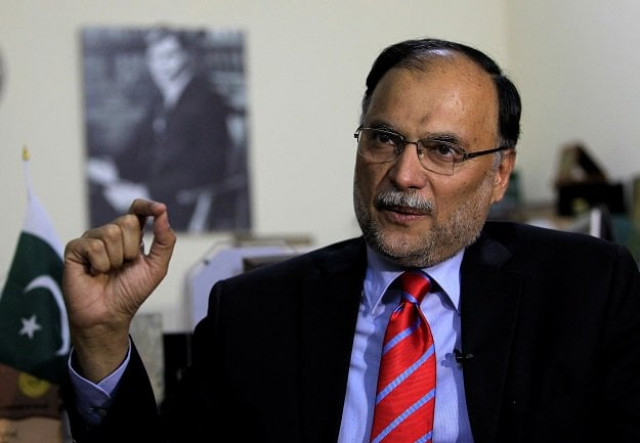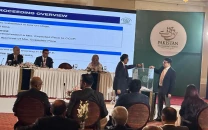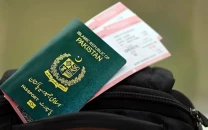Chinese currency to get same status as the US dollar in Pakistan
Under CPEC Long-Term Plan, bilateral trade could see usage of renminbi

Interior Minister Ahsan Iqbal. PHOTO: REUTERS
Planning and Development Minister Ahsan Iqbal and Chinese Ambassador Yao Jing on Monday launched the plan for 2017-30 that set out the building conditions of CPEC. The document underlines that governance deficiencies and uneven regional development in Pakistan are challenges to CPEC’s implementation. It also highlights risks from adjustments of foreign policies of the ‘world powers’ towards this region.
Among the most salient features of the plan are treating renminbi (RMB) equal to the United States dollar and allowing Chinese investment in agricultural production.
The decision to use renminbi as the second international currency will lessen Pakistan’s reliance on dollar. “Pakistan shall promote the construction of Gwadar Port Free Zone and explore RMB offshore financial business in Gwadar Free Zone,” the plan says. Both countries shall strengthen financial cooperation between their free trade zones and explore the formation of an RMB backflow mechanism, it adds.
“The use of Chinese currency in place of US dollar will benefit Pakistan,” the planning minister told The Express Tribune. He said the RMB could be used in bilateral trade but not inside Pakistan. “The use of Chinese currency will reduce our reliance on the US dollar,” Iqbal said. He said China desired that RMB be used for all financial and commercial transactions between the two countries.
Pakistan has taken a bold step by accepting the Chinese demand, as the country’s foreign exchange regime currently allows only the use of dollar for international trade. The decision, which may take up to three years to implement, will extend to the RMB all the incentives currently available to the greenback, according to government officials.
Pakistan rejects use of Chinese currency
The long-term plan states that the two countries should promote monetary cooperation between their central banks and explore enhancing the scope of bilateral currency swaps. They will also assign the foreign currency to domestic banks through credit-based bids to support financing for projects along CPEC and promote settlements in RMB and rupees to reduce the demand for third-party currency.
“The two sides will also actively explore use of bilateral currencies for the settlement of bilateral trade and investment under the relevant arrangements,” it says. They will encourage clearing and settlement for the financial institutions from both sides through a Cross-Border Inter-Bank Payment System, promote free flow of capital in an orderly manner and enhance facilitation of cross-border transfer of legitimate funds.
Not only that, “both countries shall …establish and improve a cross-border credit system and promote financial services such as export credit, project financing, syndicated loan, trade finance, investment bank, cross-border RMB business, financial market, assets management, e-bank and financial lease; support the project financing by RMB loans and establish the evaluation model of power bill in RMB.”
Pakistan’s federal and provincial governments, enterprises and financial institutions will explore effective ways to conduct RMB financing in Mainland China, Hong Kong and other offshore RMB centres. Chinese and Pakistani market players will be supported and encouraged to finance projects related to CPEC in the international market and Pakistan.
“By no means is the LTP final and perfect, as it can be adjusted according to the ground realities,” said Yao, the new Chinese Ambassador in Islamabad. He said that the plan demonstrated China’s long-term commitment to Pakistan’s development. The ambassador expressed hope that other neighbouring countries would get benefit from the Chinese development model that was based on fairness and mutual respect.
The plan also strikes a note of caution -- “as long as the governments and people of the two countries treat each other with all sincerity and cooperate sincerely, they will build the CPEC into an open, inclusive one with economic prosperity, social stability and security, and the wellbeing of people”. Both governments acknowledge that the plan has an ambitious goal and an arduous task.
CPEC could turn into a nightmare if Pakistan keeps tariffs high
The document defines CPEC as “a growth axis and a development belt featuring complementary advantages, collaboration, mutual benefits and common prosperity”. The long-term cooperation is built around seven pillars that cover every possible aspect of economic and financial cooperation.
The corridor’s core and radiation zones present the spatial layout of “one belt, three axes and several passages”. “The CPEC will greatly speed up the industrialisation and urbanisation process in Pakistan and help it grow into a highly inclusive, globally competitive and prosperous country capable of providing high-quality life to its citizens.”
However, it has been cautioned that Pakistan needs to address major bottlenecks to economic and social development to sustain the economic growth momentum. “The energy, infrastructure, administration and governance deficiencies, besides unbalanced regional economic and social development, and external sector vulnerabilities need to be monitored to avoid any possible challenge to CPEC.”
Timeline of goals
According to the plan, CPEC should take the initial shape by 2020 and have its basic construction done by 2025 with the industrial system approximately complete and major economic functions brought into play in a holistic way. By 2030, the building phase should be accomplished, the endogenous mechanism for sustainable economic growth in place and CPEC’s role in stimulating economic growth in Central and South Asia brought into holistic play. South Asia shall grow into an international economic zone with global influence.
It says the commercial projects should be operated in a market-oriented way; quasi-commercial major infrastructure projects may adopt the public-private partnership mode and non-commercial projects concerning people’s livelihood should involve multiple participants and be implemented through fair competition.
The plan lays emphasis on capacity expansion of railway lines and new projects. In the energy sector, the cooperation will be for the development of oil and gas resources and establishing refineries and storages along the route will be considered. Both countries will actively promote river planning and preparatory work of major projects to accelerate hydro-electric power development.
Sheer size of CPEC portfolio appals IMF
Pakistan’s industries will be encouraged to move away from assembling imported parts and components to localised production and Chinese enterprises to enter the Pakistan market for developing energy-efficient industry.
Both countries will promote industrial capacity cooperation in sectors such as chemical and pharmaceutical, engineering goods, agro, iron and steel, light manufacturing and home appliances and construction material.
Agriculture sector
China and Pakistan should give full play to their own comparative advantages to strengthen agricultural infrastructure construction within the CPEC coverage, the plan says. It calls for cooperation in biological breeding, production, processing, storage and transportation; infrastructure construction; disease prevention and control; water resources utilisation, conservation and protection; land development and remediation; ICT-enabled agriculture and marketing of agricultural products. The aim is to promote systematic, large-scale, standardised and intensified construction of agricultural industry.
China will cooperate for strengthening drip irrigation technology and improving post-harvest handling, storage and transportation of products.
The plan also says the countries should exploit the tourism resources in regions along CPEC, especially the border areas.



















COMMENTS
Comments are moderated and generally will be posted if they are on-topic and not abusive.
For more information, please see our Comments FAQ